 |
|
The I Ching & The Human Body
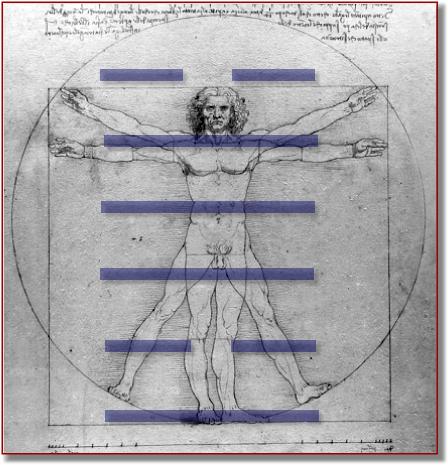
Leonardo da Vinci, Vitruvian Man, circa 1490.
Source: Wikipedia Commons. With Hexagram #49, Revolution.
The I Ching conveys a wisdom that is not held in the purview of any organized religious system. Chinese in origin, the I Ching is said to have come from the mind of Fu Xi, one of China's earliest legendary rulers. The emergence and spread of the I Ching occurred during or before the Xia Dynasty and was one of the first systems of Chinese thought that came into written form in the 13th Century BCE, making it arguably the world's oldest book and one that preceded the Buddha by nearly a thousand years.
I discovered the I Ching in high school and went so far as to cut my own yarrow stalks, the traditional way of consulting the book, though for the next two decades I remained mostly mystified by the results I got when using it. In the early 1990s I met a master of the I Ching, Lakota Howard Bad Hand; from him I learned the "inner logic" of the I Ching and was finally able to begin making sense of the book. It's now been part of my life for over forty years. I've worn out several copies of the familiar Wilhelm-Baynes book with the yellow cover, but I've also encountered many other translations of the I Ching and, more significantly, have encountered what I call "contemporary emergences" of the I Ching, systems in which the I Ching becomes a map of the human body psyche and the human body itself.
Through encountering and applying myself to these various I Ching systems I gradually began to form an overlapping understanding or synthesis; this synthesis has become my class, I Ching and the Human Body. In this article I will share an overview this synthesis, Part One.
The Traditional I Ching
We'll begin by looking briefly at the "traditional" I Ching, a book of sixty-four hexagrams which together describe the various situations we find 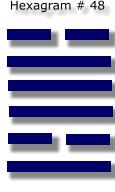 ourselves encountering in life. Throughout history the I Ching has been considered a book of wisdom and a tool of divination. Divination, in the I Ching sense, does not so much mean predicting the future as mapping the trend of the present moment (and the past that has given rise to the present moment). The I Ching is unique in describing "the time" we are in, when means both the trend of time and the possibilities within it. For instance, Hexagram #48, Revolution, means that the time we are in is one which a change of organization is happening and, if we can perceive the nature of this change - the new organizing principle - we will "be believed" when we speak of it. In this way we can "bring about a revolution."
ourselves encountering in life. Throughout history the I Ching has been considered a book of wisdom and a tool of divination. Divination, in the I Ching sense, does not so much mean predicting the future as mapping the trend of the present moment (and the past that has given rise to the present moment). The I Ching is unique in describing "the time" we are in, when means both the trend of time and the possibilities within it. For instance, Hexagram #48, Revolution, means that the time we are in is one which a change of organization is happening and, if we can perceive the nature of this change - the new organizing principle - we will "be believed" when we speak of it. In this way we can "bring about a revolution."
Each hexagram is composed of six broken or unbroken lines, reflecting respectively the yin/yang duality of the cosmos; light/dark, masculine/feminine, heaven/earth, etc. Each hexagram is 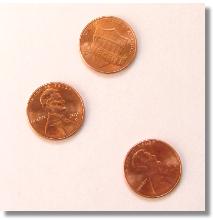 composed of two trigrams which themselves represent elemental energies, the processes of nature. Thus the I Ching, like Taoism itself, finds nature to be the model from which wisdom can be perceived and understood. The two trigrams that make up the hexagram interact in ways that are predictive of the time we are in. Once, more, each of the six lines have various individual meanings. The meaning of both the trigrams and the six lines taken as a whole become a model for looking at a life situation, a question or issue that we have. The hexagram is most commonly derived by simply throwing three pennies six times and recording the outcome of the throw (see this guide to deriving the hexagrams). Because we cannot control the outcome of the tossed pennies, the throw falls outside of the purview of ego and, instead, mirrors the larger pattern of the Tao of the present moment. From that we are given advice on how to handle the issue at hand.
composed of two trigrams which themselves represent elemental energies, the processes of nature. Thus the I Ching, like Taoism itself, finds nature to be the model from which wisdom can be perceived and understood. The two trigrams that make up the hexagram interact in ways that are predictive of the time we are in. Once, more, each of the six lines have various individual meanings. The meaning of both the trigrams and the six lines taken as a whole become a model for looking at a life situation, a question or issue that we have. The hexagram is most commonly derived by simply throwing three pennies six times and recording the outcome of the throw (see this guide to deriving the hexagrams). Because we cannot control the outcome of the tossed pennies, the throw falls outside of the purview of ego and, instead, mirrors the larger pattern of the Tao of the present moment. From that we are given advice on how to handle the issue at hand.
In brief, this is one approach to describing the I Ching as a tool of divination (I say "one approach" because the I Ching truly opens to each individual in unique ways). Each hexagram is a matrix comprised of intersecting levels of meaning. These meanings are models for showing the situations we find outselves in. As one grasps these individual meanings one expands one's ability to intuitively recognize what the I Ching is saying. Now we will look at how some these various meanings are expressed.
Hexagram as Inner and Outer Trigrams
A hexagram is composed of two trigrams: the lower trigram, also called "inner" or "within," and the upper trigram, also referred to at "outer" or "without." As in all aspects of the hexagram, the trigrams have various meanings. Primarily, though, the trigrams symbolize eight elemental processes or aspects of nature: heaven, earth, fire, water, wind, lake or marsh, thunder and mountain. Each of these elements has a vertical (and in one case horizontal) movement. For instance, heaven, thunder and fire move strongly upward, whereas earth and water move downward or descend. If the movement of both trigrams is upward, the overall judgment of the hexagram - all other aspects being equal - is often favorable, whereas if the trigrams "pull apart" - the lower descending the upper ascending, the judgement is typically unfavorable because there is no union of heaven and earth.
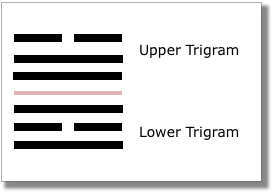
In our example above, #49 Revolution, fire or illumination is within and the "joyous lake" is without. Lake is connected with speech, so the situation is one in which inner clarity can be spoken to the world at large. Both trigrams "move" in the same direction - fire rises and so does the joy connected with lake - boding well for a positive outcome.
The key point about the trigrams as elements is that the I Ching, at it's basis, uses nature, the elements themselves, to reflect our situation and question. When we use the I Ching we are tuning into an elemental process, something different and more fundamental than simply pondering the question in our head.
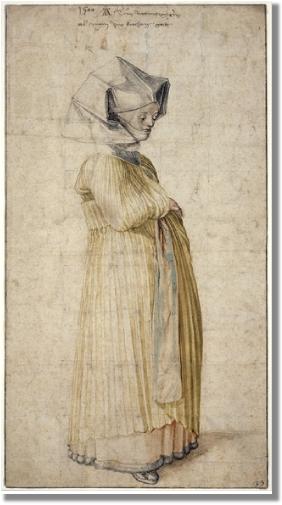 Another aspect of the lower and upper trigrams is as subjective and objective, though these terms aren't entirely apt. The lower or inner trigram refers to the mood or emotional feeling tone that we feel within. The outer refers to the qualities we feel without. In looking at this drawing by Albrect Dürer, we can see the woman's inner mood, and the drawing, devoid of all objects but the woman herself, tells us something about the outer mood. At any given time we always have an inner mood and a feeling for the world without, an outer mood. For example, on a given day we might say, "I feel good, but I'm finding this morning to be somewhat irritating." This could be called, firm within, danger or pitfall without.
Another aspect of the lower and upper trigrams is as subjective and objective, though these terms aren't entirely apt. The lower or inner trigram refers to the mood or emotional feeling tone that we feel within. The outer refers to the qualities we feel without. In looking at this drawing by Albrect Dürer, we can see the woman's inner mood, and the drawing, devoid of all objects but the woman herself, tells us something about the outer mood. At any given time we always have an inner mood and a feeling for the world without, an outer mood. For example, on a given day we might say, "I feel good, but I'm finding this morning to be somewhat irritating." This could be called, firm within, danger or pitfall without.
The Hexagram as Time
As well as being the expression of two trigrams, each hexagram depicts time, or the "time we are in." The hexagrams depicts many different types of time; studying the 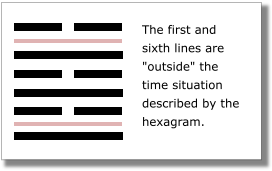 I Ching can help us realize the nature of time in all its dimensions (as well as time's non-existence). From one dimension of time, the first and sixth lines are traditionally considered "outside" the hexagram in that the first is just "entering" and thereby considerably connected to the past, and the sixth or top line is "leaving" or already part of the future, part of the next hexagram. (These lines are not necessarily any less significant in a given hexagram, nor do they always carry these meanings; general principles are subservient to the makeup of each specific hexagram.) All the lines can represent time in various ways, including linear, seasonal or cyclical time, and the "time for" - i.e., when a specific action become possible. Above all, each hexagram represents the "time we are in" as potential for growth and manifestation of our highest calling.
I Ching can help us realize the nature of time in all its dimensions (as well as time's non-existence). From one dimension of time, the first and sixth lines are traditionally considered "outside" the hexagram in that the first is just "entering" and thereby considerably connected to the past, and the sixth or top line is "leaving" or already part of the future, part of the next hexagram. (These lines are not necessarily any less significant in a given hexagram, nor do they always carry these meanings; general principles are subservient to the makeup of each specific hexagram.) All the lines can represent time in various ways, including linear, seasonal or cyclical time, and the "time for" - i.e., when a specific action become possible. Above all, each hexagram represents the "time we are in" as potential for growth and manifestation of our highest calling.
Among other meanings, the aspect of a given I Ching's judgment in terms of time will give us advice, quite obviously, on our timing with a situation; whether it is time to act or time to refrain from action. Each line has a time characteristic associated with it: for example the line that is "entering" is often not yet prepared to act, whereas the top line often has lost the opportunity to act, or if it does act, will do so in an inappropriate way.
The Hexagram as Group, Society or Organization
This diagram depicts another traditional way in which a hexagram's meaning is derived. In this case, each line represents the position of a given individual within a hierarchical group or organization. The first 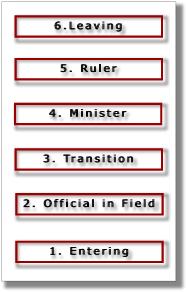 and sixth lines are somewhat "outside the situation" - as explained above. The second line is ideally an active and devoted agent of the ruler; the third line bears the greatest challenge of the intersection of the inner and outer trigrams and therefore is often in "trouble"; the forth line, called the "minister," ideally selflessly supports the ruler; the fifth line is the ruler, being in the upper trigram and by virtue of being "central"; the ruling line generally has a favorable judgment attached to it. The sixth line represents heaven and/or that part of the situation that has already "left" the hexagram; the judgement of the sixth line can be very favorable or very unfavorable in that sometimes the line has the detachment and perspective of heaven, sometimes it has the stridency of arrogance.
and sixth lines are somewhat "outside the situation" - as explained above. The second line is ideally an active and devoted agent of the ruler; the third line bears the greatest challenge of the intersection of the inner and outer trigrams and therefore is often in "trouble"; the forth line, called the "minister," ideally selflessly supports the ruler; the fifth line is the ruler, being in the upper trigram and by virtue of being "central"; the ruling line generally has a favorable judgment attached to it. The sixth line represents heaven and/or that part of the situation that has already "left" the hexagram; the judgement of the sixth line can be very favorable or very unfavorable in that sometimes the line has the detachment and perspective of heaven, sometimes it has the stridency of arrogance.
Within a given hexagram, each line has an active interrelationship with the others and the quality of this relationship produces a judgment for the line as well as advice on how to best conduct oneself. It is in the judgments of the lines that the I Ching has an uncanny and often stunning ability to help us sort out interpersonal difficulties.
The Hexagram as Body and Psychology
We'll now look at the hexagram in its most somatic expression as a 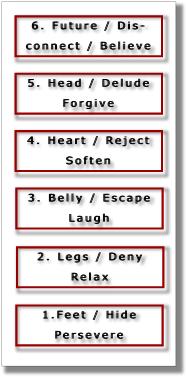 symbolic model of the human body and its psychology. We can see through this diagram that the hexagram in its verticality mirrors the vertical nature of the human spine and body. Each part of the body has an associated shadow or wound state, which in traditional I Ching language is called the "inferior." The first line, for instance, is connected with the feet, that part of our body that first enters new situations. The shadow or wound state of the first line is to try to hide out of insecurity. In hiding, this line cannot come into its own authenticity. The way to enact or embody psychological health - to be in the "superior" - is simply to persevere. The keynote to persevere is a "circuit breaker" or quality that will ground us, in literally keeping our feet connected to the ground we recognize that the beginning of any new experience or challenge requires steady, grounded perseverance. The circuit breaker is pivotal action that will shift our psychology from the shadow state to the state of gift.
symbolic model of the human body and its psychology. We can see through this diagram that the hexagram in its verticality mirrors the vertical nature of the human spine and body. Each part of the body has an associated shadow or wound state, which in traditional I Ching language is called the "inferior." The first line, for instance, is connected with the feet, that part of our body that first enters new situations. The shadow or wound state of the first line is to try to hide out of insecurity. In hiding, this line cannot come into its own authenticity. The way to enact or embody psychological health - to be in the "superior" - is simply to persevere. The keynote to persevere is a "circuit breaker" or quality that will ground us, in literally keeping our feet connected to the ground we recognize that the beginning of any new experience or challenge requires steady, grounded perseverance. The circuit breaker is pivotal action that will shift our psychology from the shadow state to the state of gift.
Daily Use of the I Ching
I've thrown the I Ching on a daily basis for over fifteen years. When I do this - and I always do it first thing in the morning - I'm not asking a specific question, but simply being open to what the book says to me, to what it can be as a mirror and guide. Sometimes it answers a troubling thought or emotional conflict I woke up with. In that case it is typically exacting and dead-on, as if someone has just read my mind. Other times it sets out a guideline for the day: Pushing upwards in darkness, for instance (#46, sixth line), an indication to persevere without knowing exactly why. At other times it is uncannily, even unbelievably prophetic; a challenge or blessing that I cannot yet even imagine comes to be the case by, say, 11:00 AM that morning.
Daily consulting of the world's oldest text is a form of sacrement, open-ended inquiry and even play. I encourage people to consider tying this daily practice as an ideal way to learn the I Ching. Fluency with the I Ching develops naturally as its insights confirm our deepest aspirations. After a while we find we’ve memorized all sixty-four hexagrams without exactly setting out to.
Encountering the I Ching on a daily basis helps meet the fundamental human needs to be mirrored and find guidance. A human life is ideally one of continuous discovery, learning and growth. We become so easily stuck in habitual or wound patterns in part because it is difficult to see our own blind spots. The I Ching reveals patterns and is a real tool of mirroring and self empowerment.

"I Ching door," Karme Choling,
Barnett, Vermont.
Also: See my article, I Ching: The Four Eternal Hexagrams and the Shambhala Path of the Warrior.
![]()
